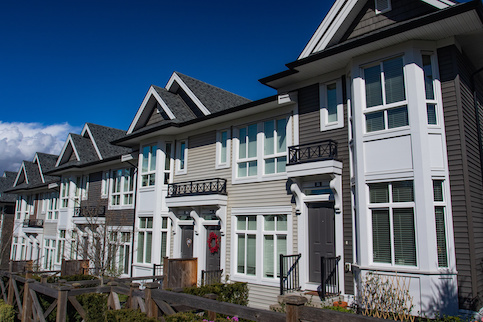If renting out a single-family home provides hundreds of dollars of rental income every month, would you jump at the chance to multiply that number by two or more? Multifamily homes are increasingly popular among investors for their increased revenue potential and lower vacancy rates.
This article will delve into how to buy a multifamily property and the reasons to do so. Additionally, you’ll get insight into why this asset is an excellent way to diversify your portfolio. Here are the details.
What Is A Multifamily Property?
A multifamily property is a building that houses separate units where more than one family can reside. A multifamily home has a designated kitchen and bathroom for each unit. In addition, each unit likely has a separate entrance, utility shut-off valves, and utility meters. Plus, each unit has its own legal address.
These characteristics separate multifamily homes from large houses shared by several families or homes with sprawling finished basements. Examples of multifamily homes are duplexes, townhomes, condos or apartments.
Multifamily Properties Vs. Single-Family Properties
While single-family homes come in various forms, their distinguishing factor from multifamily properties is the number of units. Technically, a structure with four or fewer units is a single-family home, while a building with five or more units is a multifamily property. The distinction is critical for financing because multifamily homes have different mortgage types and limits. The typical individual investor is likely looking to invest in one- to four-unit investment properties with traditional mortgage financing. Many mortgage lenders, are only willing to lend on these types of properties. For these reasons this article will focus on two- to four-unit properties and refer to them as multifamily properties.
See What You Qualify For
Buy A Home
Discover mortgage options that fit your unique financial needs.

Refinance
Refinance your mortgage to have more money for what matters.
Tap Into Equity
Use your home’s equity and unlock cash to achieve your goals.
Why Should You Buy Multifamily Properties?
Multifamily units are attractive to real estate investors because one asset adds multiple units to their portfolio, granting cash payments and equity. Read on to see how these properties can benefit you.
Cash Flow
Unlike stocks or bonds, real estate investing can provide monthly rental payments. Multifamily units bring this advantage, meaning an investor can purchase a building and receive income once tenants rent it.
Rental Income
Aside from serving as a steady cash stream, rental income can cover some or all of the investor’s mortgage payment, meaning the asset pays for itself. As a result, rental income can help you afford a more expensive home than you could afford by paying the mortgage on your own.
Tax Benefits
Real estate investments, such as multifamily properties, bring numerous tax benefits. First, you can deduct property taxes, insurance, mortgage interest, repairs, improvements, rental advertisement and management costs from your taxes. These expenses will reduce your tax burden, allowing you to keep more of your income.
In addition to those standard deductions, your property might qualify for depreciation tax benefits. You can obtain this deduction by showing the IRS that the property in question has a determinable useful life. Usually, the IRS sets this lifespan at 27.5 years. If you receive the deduction, it will help offset the cost of maintenance on the property over time. Therefore, you’ll get a tax advantage for holding onto your investments for the long haul.
With a 1031 exchange, if your multifamily home appreciates significantly, you can defer your tax payment from the value increase by selling the building and buying a similar one within 180 days. For example, say you bought a multifamily home for $150,000. Five years later, it’s worth $400,000, and you’re ready to sell. Usually, you’d have to pay capital gains taxes on the $250,000 of profit. Instead, you can plan out a 1031 exchange before you sell, then use the profits to buy another multifamily home without paying taxes. Remember, the exchange is a tax deferral, meaning you’ll pay taxes if you decide to cash out and not buy another property.
Rent-Free Living
You can also purchase a multifamily home and live in one of the units. Then, you can rent out the other units, and your rental cash flow pays for your primary residence.
Diversification
Diversifying your portfolio means not putting all your eggs in one basket when investing. So, if you have a healthy IRA or 401(k) and want to invest more, you can acquire a multifamily property. Real estate is a distinct asset type, and diverse assets can help you weather economic turbulence, keeping your portfolio healthy if other assets go belly up.
See What You Qualify For
You can get a real, customizable mortgage solution based on your unique financial situation.
Requirements For Buying Multifamily Properties
Buying a multifamily property means getting the necessary financing. Here’s what lenders look for when a borrower approaches them for a multifamily property loan.
Credit Score
A credit score is a numerical representation of your reliability as a borrower. Your credit history, including your past and current debts, impacts your score. The better your score, the more access to loans and lower interest rates.
The loan type influences the credit score you need. For example, government-backed loans, such as VA and FHA loans, usually require a score of 580. On the other hand, conventional loans often require a score of 620, while you’ll need a score of 680 for a jumbo loan.
Down Payment
A down payment is a lump sum you pay toward the property’s purchase price. For conventional loans, the minimum down payment for multifamily properties is 15% if you will live in one of the units and 25% if you don’t. This range means a $300,000 home would require a down payment of $45,000 or $75,000 if you live elsewhere. As a result, it’s one of the most expensive parts of buying a home. Some lenders may also differentiate between two-unit properties and three- to four-unit properties and have different down payment requirements for each.
However, down payment requirements vary by loan type. For instance, FHA loans require 3.5% to 10%, depending on the borrower’s credit, while VA and USDA loans don’t require down payments.
Debt-To-Income Ratio
Your debt-to-income ratio (DTI) is a comparison between your monthly income and debt obligations. In other words, your DTI is the percentage of income that goes toward debts. For example, if you have $5,000 of monthly income and $1,500 of monthly debt payments, your DTI is 0.3, or 30%. Generally, you need a DTI of 0.5 (50%) or lower to qualify for conventional loans. DTI’s closer to 50% may require better credit scores, additional funds in reserves or a different down payment. Government-backed loans generally have higher DTI maximums than conventional loans.
How To Buy A Multifamily Home
You can buy a multifamily (two- to four-unit) property by following the same steps to buying a house required to buy a single family property. Here’s what to do:
1. Find A Property
First, identify your preferences for a home. For example, it’s best to know the price range, building type and size you want before you start looking. Then, you can browse homes online and in person. Remember, you might not find the perfect match. So, while you can keep your ideal home in mind as the standard, it helps to remain flexible when viewing houses.
In other words, prioritizing your wants and needs will make your search easier. Online search tools will prescreen home listings within your price range. If you’re struggling to find the right house, your real estate agent can provide guidance and insight into the local housing market.
Touring different areas and houses requires organization and attention to detail. Taking notes on each property’s physical condition, style and location can help you remember what you liked and disliked about each one. Don’t be swayed by a lower price tag without considering the potential cost of repairs or updates. Lastly, because no home is perfect, it’s best to be realistic about what you’re willing to live without and what your budget can handle.
2. Work With A Real Estate Agent
While home buyers can buy independently, having a trustworthy and reliable real estate agent can streamline the process. For example, having a real estate professional on your side can help you find a home quicker and get a better deal. Specifically, they can review homes on the MLS and find pocket listings as soon as they emerge.
In addition, your real estate agent will negotiate on your behalf and provide expert insight into your local real estate market. These advantages can help you pounce on the ideal house and beat the competition. As a result, it’s crucial to find a real estate agent you feel comfortable with so you can approach your home search confidently. To that end, it’s best to shop for real estate agents and ask them the following questions:
- How long have you been a real estate agent?
- How familiar are you with the area?
- What is your approach to the home buying process?
- What experience do you have finding homes in my price range?
- Can you provide references from past clients?
3. Choose A Loan And A Lender
The next step in the home buying process is to find a mortgage lender and obtain preapproval for a mortgage loan. To ensure that you find the right lender for your situation, it’s helpful to compare different mortgage lenders. Each lender has its own guidelines, interest rates and closing costs, so it’s important to do your research. Requesting a loan estimate from each lender can help you compare loan terms, projected payments and closing costs.
Likewise, it’s critical to consider the various types of loans and choose one that fits your situation. Keep in mind that if you are planning to get an FHA or VA loan for a multiunit investment property it must also serve as your primary residence, meaning you’d have to live in one of the units in order to get that type of loan.
Once you select your loan type, getting preapproved is the first step to solidifying your financing. While preapproval does not guarantee the loan, it shows you have a sufficient financial background to purchase a home. Remember, getting preapproved requires a thorough investigation of your finances, including income, assets and credit rating. Therefore, a strong credit score and low DTI can help you get preapproved faster.
In addition, preapproval is helpful because it gives you a better idea of how much the lender will let you borrow and the associated costs. It also shows sellers you are serious about buying, which can help you stand out in a competitive market.
4. Make An Offer
When you’re ready to make an offer on a home you want to buy, it’s crucial to identify a reasonable price based on recent sales of similar homes in the area. Fortunately, you can ask your real estate agent to conduct a comparative market analysis for this purpose. Plus, doing so can help you find the best deals. For example, you may have more negotiation power with a home that has been on the market for over a few months.
In addition to the offer price, it’s also best to decide with your real estate agent whether your offer should include any contingencies. A contingency allows the buyer to back out of the contract without consequences if certain conditions are unmet.
One type of contingency you may want to include in your offer is a mortgage contingency, which allows you to withdraw your offer if you cannot obtain financing. Including this contingency is helpful because preapproval is not identical to obtaining financing from a lender.
Another type of contingency is a home sale contingency, which gives you a certain period to secure a buyer for your current home before you purchase the new one. Some sellers may refuse this contingency, but it’s usually worth trying.
An inspection contingency is also recommended, as it allows you to have the home inspected to ensure you understand its condition and negotiate any necessary repairs.
Remember, contingencies in your offer may impact the seller’s decision. You’ll also be required to provide an earnest money deposit along with your offer, typically 1% – 3% of the purchase price. The earnest money goes into an escrow account and counts toward your down payment and closing costs. However, if you don’t buy the home for a reason not specified in your contingencies, the seller keeps your earnest money. Therefore, it’s essential to consider potential conditions that may require you to withdraw your offer before submitting it.
The Bottom Line
Buying a multifamily property varies greatly depending on whether the property has more than four units or less than five units. Both types can provide more investment income than a single-unit property, and you can live in one of the units to reduce your housing costs. However, multifamily homes are more expensive and require higher down payments, so you’ll need sufficient financial footing to invest in this asset type. True multifamily properties of five or more units will require you to work with a commercial lender, not a mortgage lender.
Find A Mortgage Today and Lock In Your Rate!
Get matched with a lender that will work for your financial situation.

Carla Ayers
Carla Ayers is a Staff Writer for Rocket Companies and a Realtor with a background in commercial and residential property management, leasing, and arts management. She has a bachelor's degree in arts marketing and a master's degree in integrated marketing and communications from Eastern Michigan University.












